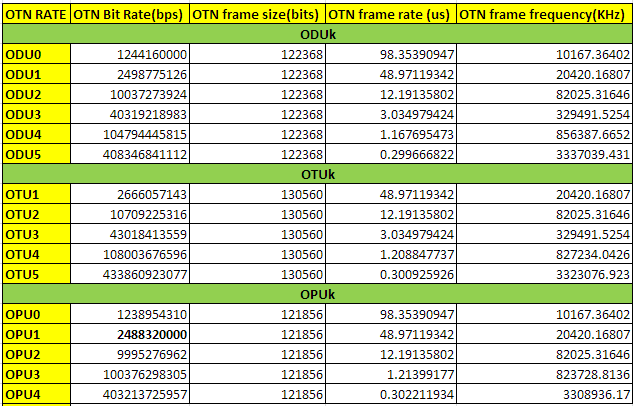**Multiplicative factor is just a simple math :eg. for ODU1/OPU1=3824/3808={(239*16)/(238*16)}
Here value of multiplication factor will give the number of times for rise in the frame size after adding header/overhead.
Example:let consider y=(x+delta[x])/x; In terms of OTN frame here delta[x] is increment of Overhead.
As we are using Reed Soloman(255,239) i.e we are dividing 4080bytes in sixteen frames (The forward error correction for the OTU-k uses 16-byte interleaved codecs using a Reed- Solomon S(255,239) code. The RS(255,239) code operates on byte symbols.).Hence 4080/16=255.
Try to understand using OTN frames now. I have tried to make it legible.
As we know that OPU1 payload rate= 2.488 Gbps (OC48/STM16) and is frame size is 4*3808 as below.


*After adding OPU1 and ODU1 16 bytes overhead: Frames could be fragmented into following number of chunks.
3808/16 = 238, (3808+16)/16 = 239


So, ODU1 rate: 2.488 x 239/238** ~ 2.499Gbps
*Now after adding FEC bytes


OTU1 rate: ODU1 x 255/239 = 2.488 x 239/238 x 255/239
=2.488 x 255/238 ~2.667Gbps
Now let’s have a small discussion over different multiplier and divisor scenarios that will make it clearer to understand.
We know that an OTU frame 4 * 4080 bytes (= 255 * 16 * 4)


OPU representing the Payload (3824-16) * 4 * 4 = 3808 bytes (= 238 * 16 * 4) .
OPU1 is exactly the rate of STM-16.
Now,
ODU1 = (3824/3808) * OPU1 = ((16 * 239) / (238 16 *)) * OPU1 = (239/238) * STM-16
OTU1 = (4080/3808) * OPU1 = ((255 * 16) / (238 * 16)) * OPU1 = (255/238) * STM-16

OPU2 contains 16 * 4 = 64 bytes of fixed stuff (FS) added to the 1905 to 1920 .
OPU2 * ((238 * 16 * 4-16 * 4) / (238 * 16 * 4)) = STM-64 rate
OPU2 = 238 / (238-1) * STM-64 = 238/237* STM-64 rate
ODU2 = (239/237) * STM-64 rate ,
similarly
OTU2 = ( 255/237) * STM-64 rate


OPU3 Including 2 * 16 * 4 = 128 fixed stuff (FS) bytes added to the 1265 ~ 1280 and 2545 ~ 2560
OPU3 * ((238 * 16 * 4-2 * 16 * 4) / (238 * 16 * 4)) = rate of STM-256
OPU3 = 238 / (238-2) * STM-256 = 238/236 * STM-256
ODU3 = (239 / 236) * STM-256
OTU3 = (255/236) * STM-256
The OTU4 was required to transport ten ODU2e signals, which have a non-SDH based clock frequency as basis. The OTU4 clock should be based on the same SDH clock as the OTU1, OTU2 and OTU3 and not on the 10GBASE-R clock, which determines the ODU2e frequency. An exercise was performed to determine the necessary divider in the factor 255/divider, and the value 227 was found to meet the requirements (factor 255/227). Note that this first analysis has indicated that a future 400 Gbit/s OTU5 could be created using a factor 255/226 and a 1 Tbit/s OTU6 using a factor 255/225.
Unlock Premium Content
Join over 400K+ optical network professionals worldwide. Access premium courses, advanced engineering tools, and exclusive industry insights.
Already have an account? Log in here




